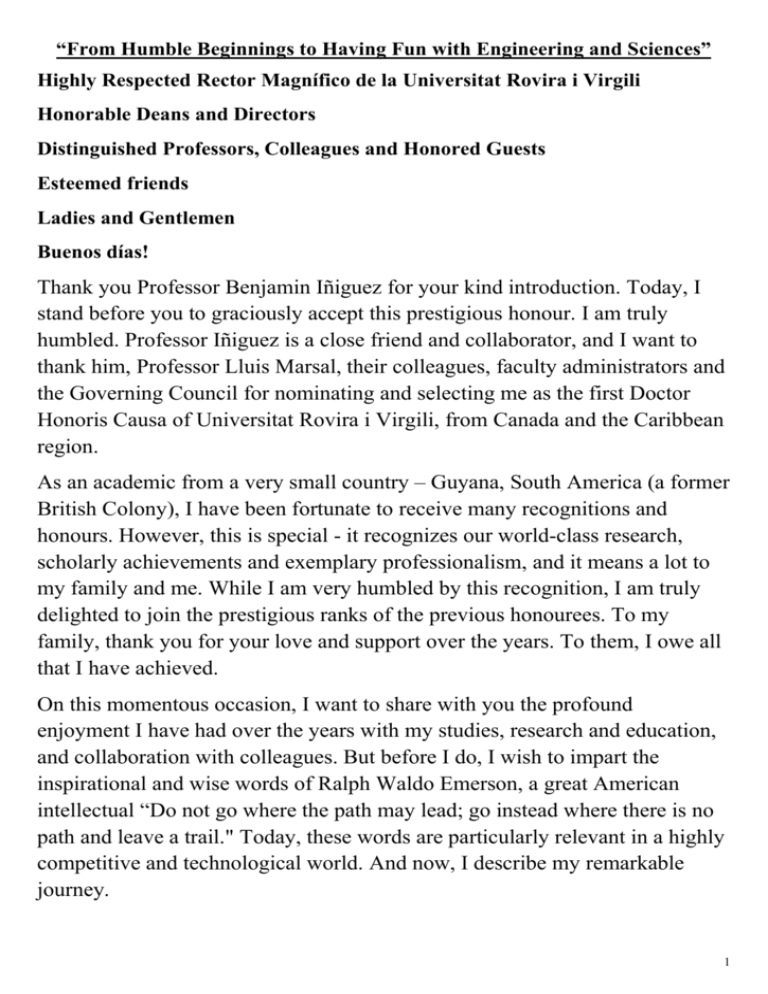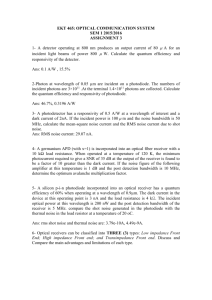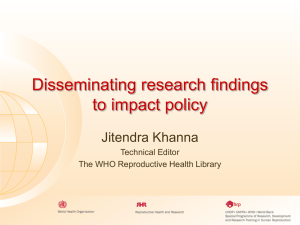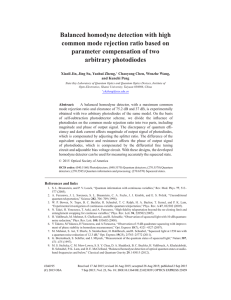Good Convocation Speech - Granada
advertisement

“From Humble Beginnings to Having Fun with Engineering and Sciences” Highly Respected Rector Magnífico de la Universitat Rovira i Virgili Honorable Deans and Directors Distinguished Professors, Colleagues and Honored Guests Esteemed friends Ladies and Gentlemen Buenos días! Thank you Professor Benjamin Iñiguez for your kind introduction. Today, I stand before you to graciously accept this prestigious honour. I am truly humbled. Professor Iñiguez is a close friend and collaborator, and I want to thank him, Professor Lluis Marsal, their colleagues, faculty administrators and the Governing Council for nominating and selecting me as the first Doctor Honoris Causa of Universitat Rovira i Virgili, from Canada and the Caribbean region. As an academic from a very small country – Guyana, South America (a former British Colony), I have been fortunate to receive many recognitions and honours. However, this is special - it recognizes our world-class research, scholarly achievements and exemplary professionalism, and it means a lot to my family and me. While I am very humbled by this recognition, I am truly delighted to join the prestigious ranks of the previous honourees. To my family, thank you for your love and support over the years. To them, I owe all that I have achieved. On this momentous occasion, I want to share with you the profound enjoyment I have had over the years with my studies, research and education, and collaboration with colleagues. But before I do, I wish to impart the inspirational and wise words of Ralph Waldo Emerson, a great American intellectual “Do not go where the path may lead; go instead where there is no path and leave a trail." Today, these words are particularly relevant in a highly competitive and technological world. And now, I describe my remarkable journey. 1 Hard work, competition, team work and respect This journey starts with my early days growing up in a small developing country in South America and the Caribbean – Guyana. I begin by illustrating the fruits of hard work, staying focussed, the challenges of being competitive, and the value of team work and respect for others. I was born into a family of very modest means. Being a middle child, I was often in the difficult position of having many responsibilities at home – a situation that some of you can relate to. This was overwhelming at times, but instead of being overcome by these circumstances, I persevered and became very skilled at balancing home responsibilities with schoolwork. Upon reflection, these early life lessons were critical to helping me excel and become a top student which earned me a place at Queen’s College, one of the premier high schools in the British Commonwealth. During high school years, my classmates and I had a friendly but competitive spirit. This served as a catalyst for hard work which made success relatively easy. It was an experience that underscored the importance of collegial competition with peers, the guidance of mentors, and diligence in improving one’s own capabilities. These all served as a solid foundation on which I entered University. However, life was not easy. Not only did I work full time as a school teacher, but I also attended university at night, often from 5 to 11 pm. This experience was vital in teaching me time management and prioritization - skills that most of you have mastered while working at URV. On successfully completing my undergraduate and graduate degrees, I was fortunate to be offered my dream job – that of a university professor. But I never forgot the lessons of humility – to give special thanks and appreciation to the many exceptional teachers I was fortunate to have. These dedicated teachers spared no efforts in guiding us toward academic excellence. They instilled in us the value of hard work, dedication and perseverance, and taught us how to use our education and skills to make intelligent choices. Next, I will discuss how academic work could be translated into engineered products, contrasting theory and practice. 2 An Academic Wading into Real-world Engineering Often, engineering professors concentrate on academic research without developing expertise to translate their work into industrial practice, or the industrial issues associated with applied research. I decided to dip my feet into this world, taking a different approach in seeking out high-impact problems to work on. Using experiences from my own scholarly work, I will provide some examples. The first relates to a visit to a cancer center that helped in better understanding their imaging needs and limitations of the technologies used at that time. This concerns our invention of the solid- state microscope for quantitative microscopy in image cytometry to optimize spatial, photometric and spectral resolution, in the late 1980’s. The patented microscope was an optoelectronic system for scanning and viewing microscopic objects in the visible light spectrum. Its main features were its simple optical path, high resolution, large field-of-view, display of the image on a monitor with overlay graphics for labelling of objects, direct access to any part of the digital image, different scanning modes including full-frame scanning and time delay integration, spectral imaging, and large dynamic range. Remember this was in the late 1980’s and early 1990’s. The solid-state microscope was successfully commercialised for medical and biomedical applications. The second, with my industrial collaborator, Nortel, was on innovations in experimental techniques to solve an important reliability problem as well as developing robust, calibrated models to optimize the manufacturability of avalanche photodiodes, and designs for succeeding generations of optical detectors to be used in fiber optic communications systems. In the 1990’s, manufacturing of reliable high-speed photodetectors was a tremendous challenge to process engineers in the major manufacturing facilities worldwide. Reliable photodetectors are critically important to long-haul fiber communication systems that propelled “information technology”. In this respect, our experimental work on combining our expertise in electrical noise and the physics of avalanche photodiodes, was the key to guide process engineers on the impact of different processing recipes on the reliability of avalanche photodiodes. We studied, in detail, the effects of process variations 3 on noise in avalanche photodiodes, and showed that it can be used as a powerful tool to predict how more reliable photodiodes can be fabricated. We also used noise to trace process improvements in APDs; improvements that could not be detected by standard electrical of optical testing methods. The third and another outcome of my work in industry was the recognition of the importance of electrical noise. This was counter to the popular trends where most researchers concentrated on the signal and its enhancements. Here, our work on high-frequency noise is especially relevant, given the preponderance of wireless, portable consumer products. In fact, we have been at the forefront in attacking noise issues in devices and integrated circuits. For predicting circuit and system performance, not only are computationally efficient and accurate models needed, but accurate model parameters serve as the key ingredients in model predictions. In the modeling area, we settled the debate among researchers about the correct physical model for the channel noise. Next, we developed an innovative technique to directly extract all the noise sources from measurements, thereby providing device and circuit designers with accurate model parameters. Also, we developed a computerbased technique for calculating the high-frequency noise parameters of any active device using a generalized approach based on network analysis and matrix reduction techniques. We then successfully applied this technique to field-effect transistors, the dominant technology for all electronics. In addition to our models and algorithms to accurately predict noise, we took the extra steps to show how they can be implemented in popular circuit simulators to guide the design process and predict performance characteristics before chips were manufactured. Our models enable circuit designers to choose design and operating conditions to mitigate this signal-to-noise dilemma, and are extensively used by the industry worldwide. Next, I will discuss academic life and education that cross disciplinary boundaries. Having Fun with Engineering and Sciences Here, I will describe some of our current and on-going research which will highlight rapidly emerging trends that require the convergence of expertise to 4 solve important or pressing problems in our society. The first example is our research and technology development of low-cost sensors for water quality monitoring. This research is motivated by the fact that the availability of safe drinking water is fundamental to our health. Unfortunately, the sustainability of this precious resource is under threat due to factors such as population growth, environmental degradation and climate change. As water resources become more stressed, ensuring safe drinking water is increasingly important. Currently, monitoring of microbiological contamination of water is laboratory based, time consuming, and compromises the timeliness of health advisory warnings when water contamination is found. Therefore, rapid detection of unsafe water can contribute greatly to mitigating the morbidity and mortality associated with waterborne diseases. Our on-going research is aimed at the development of scalable engineering solutions in portable, real-time monitoring of water resources so that timely information can be obtained about the quality of water. This research in water quality monitoring necessitates effective collaborations with engineers from different disciplines, scientists and public health officials. For our water monitoring systems, we have to develop biosensors and electrochemical reference electrodes, micro-fabricate preprocessing modules, control and signal processing electronics, functionalize surfaces, and attach biomolecules. These new monitoring systems will eliminate the main bottleneck – that of real-time monitoring of water resources. As you can imagine, the creation of these systems requires diverse expertise and exceptional team work. It is believed that these types of projects will become increasingly important to solve pressing current and future problems such as food and water safety, healthcare and energy, to name just a few. The second example is in developing low-cost, miniaturized and sensitive systems for minimally invasive screening and diagnoses of early stage malignancies. This research is motivated by the premise that the sooner a disease is caught, the higher the chances are for recovery. This research involves the use of rapidly emerging technologies such as nanoelectronics, photonics, optics, and molecular imaging. At present, our focus is on minimal invasive endoscopic imaging technologies that require expertise in multiple 5 disciplines such as gastroenterology, minimally invasive surgery, and photonic, electronic and mechanical engineering. Such research programs require engineers, scientists and clinicians to work collaboratively and synergistically for the realization of these new screening and diagnostic devices. As a specific example, not only do we have to develop optical imagers capable of single photon counting with high temporal resolution to investigate autofluorescence from biological samples, but the optics should be integrated so the system has a small form factor. And for invivo applications, biocompatible coatings with good optical transmission properties are required. In addition, the hardware and software should be user friendly. On a different note, an often overlooked aspect of these multi-disciplinary projects is communication. In fact, communicating effectively is critical, not only for researchers in arts or humanities, but especially for those in other fields such as engineering, science or medicine who may be collaborating on large projects locally or globally. Further, if we examine some of the grand challenges that are to be tackled – universal access to clean water, personalized learning, or improved and sustainable healthcare, effective solutions will be created by teams of researchers from different disciplines who must find commonalities in communication. Over time, these two and other examples of our research have led to an important realization, that greater success and satisfaction come from working in partnership to make a difference, whether it is helping to solve societal problems related to health care or the environment. In our career, we may have to step out of our comfort zone in interacting with colleagues in different disciplines, thereby attaining higher goals not feasible without partnerships. In my career, I have been extremely fortunate to work with outstanding students, researchers and collaborators, who have made such partnerships rewarding and enjoyable. They have taken our ideas and proposals to new heights, and are largely responsible for our esteemed academic reputation, respect and recognition. Their training in a multi-disciplinary environment places them in a unique and elite position to appreciate the challenges and enjoy the fruits of such collaborative projects. 6 Changing Times, Tolerance and Adaptability I previously discussed the evolutionary and changing times we live in and the need to be able to adjust and adapt. My ability to adjust and adapt has been a major part of my success. Besides working in my home country, Guyana, I had the good fortune of working in North America, Europe and Asia. This afforded my family and me the unique privilege to appreciate the vast spectrum of cultural diversity, rich traditions and work ethics and practices that have helped us develop and shape new and meaningful perspectives. In your work career, you may also seek national or global opportunities that grant you these very privileges that often times encourage cultural tolerance and adaptability, both within the parameters of work and society. Such opportunities are integral and crucial to advancing your professional career and personal life. In addition, a healthy balance between work and family is an often overlooked aspect of success. Like many of you, personally, I have managed to navigate both successfully. As university faculty, most of us work very hard to achieve our academic goals. However, often we find that real life is much more complicated than being only a researcher in academia. It may be that we will encounter challenging times, either with our research team, in funding, or in collaborations, and these times can be overwhelming. But do not despair. Many of the same skills we learnt as researchers – determination, perseverance and optimism – will be crucial as we navigate through these challenges. And do not underestimate the power of patience and perseverance. Lack of these two attributes may make succeeding difficult. To quote Einstein on patience, “It’s not that I’m so smart, it’s just that I stay with problems longer.” At this time, I would like to share and impart some inspiring words of wisdom, especially for my younger colleagues. Be prepared for the unexpected. It may be upon you before you know it. So adapt and use your knowledge and skills to create novel and workable solutions. And do not be afraid of controversial areas of research, even if there is opposition from mainstream “experts”, you may be far ahead of your competitors. Through unwavering, intelligent dedication, and a high standard for research work and ethics, you may find 7 exceptional rewards and personal satisfaction. And recognizing that education is the key to a great and satisfying future, we must prepare for it today for a better tomorrow. Also, you will find that the combination of real-life experiences and academic preparedness are effective tools that equip you to creatively deal with challenges in your life. To end, I quote from two persons I admire very much, Aristotle who stated “The roots of education are bitter, but the fruit is sweet” and the recently departed Nelson Mandela who said “Education is the most powerful weapon which you can use to change the world.” So let us all work hard, persevere and adapt. And always remember, humility is the mark of greatness. Also, even though we are grown and have successful careers and lives, we should not forget to thank our family, teachers and mentors for their support and guidance throughout our careers. And as we look to the future, we must remember that we are privileged ambassadors of change. Thank you very much and good luck to everyone. Muchas gracias y buena suerte a todos. 8










